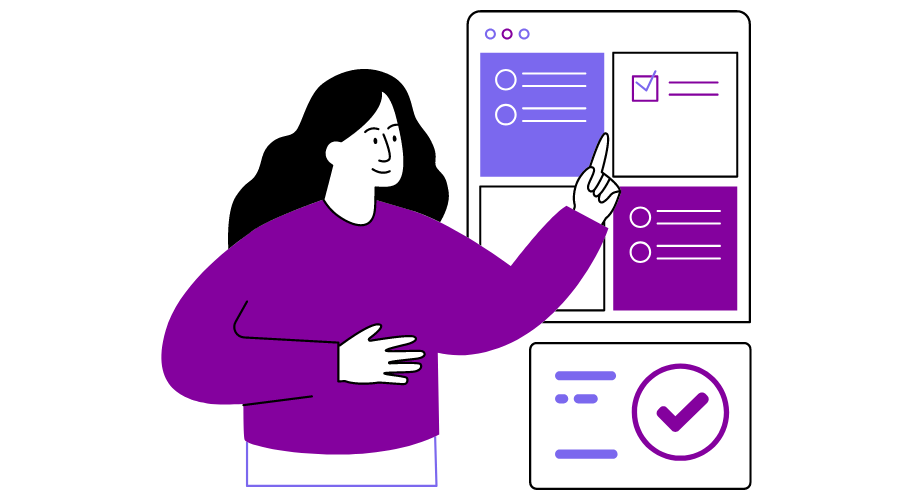Understanding users is crucial for any business.
They drive your product's success.
To truly grasp what users want, you need to step into their shoes. Knowing their needs, preferences, and behaviors can guide your product development, marketing strategies, and customer service efforts. Engaged users can become loyal customers, advocates, and even contributors to your product's growth.
This post will explore the different aspects of users and how understanding them can benefit your business. By the end, you'll have a clearer idea of why users are essential and how to cater to their needs effectively. So, let’s dive into the world of users and discover what makes them tick.
User Research
User research is a crucial part of understanding your audience. It helps in creating products that meet their needs. By listening to users, you can gather valuable insights. These insights can guide your design and development process. There are many methods to conduct user research. Let's explore some of the most effective ones.
Surveys And Questionnaires
Surveys and questionnaires are great tools for gathering user feedback. They allow you to reach a large number of users quickly. You can ask specific questions to get detailed answers. This method is cost-effective and easy to distribute. Use clear and simple language in your questions. This ensures users understand and respond accurately. Analyze the responses to find common patterns and trends.
User Interviews
User interviews provide in-depth insights into user behavior. They involve one-on-one conversations with users. This method helps you understand their thoughts and feelings. Prepare open-ended questions to encourage detailed responses. Listen carefully and take notes during the interview. This helps in identifying pain points and areas for improvement. User interviews can reveal valuable information that surveys might miss.

Credit: community.blackbaud.com
Persona Development
Understanding users is key to creating successful products. Persona development helps in this process. It involves creating detailed profiles of typical users. These profiles help designers and marketers make informed decisions.
Creating User Personas
Start with research. Conduct surveys, interviews, and observe user behavior. Gather data about demographics, goals, and challenges. Identify patterns and group similar users together.
Create detailed profiles for each group. Include fictional names, pictures, and backgrounds. Describe their motivations, goals, and pain points. Make the personas as realistic as possible.
Using Personas In Design
Use personas to guide design decisions. Refer to them throughout the design process. Ensure the product meets the needs of the target users.
Personas help in prioritizing features. They also aid in creating user flows and interfaces. Design with empathy and keep the user at the center.
Share personas with the whole team. Ensure everyone understands the target users. This alignment helps in creating a cohesive product.
Usability Testing
Usability testing is key to creating user-friendly products. It helps identify issues users face. By conducting usability tests, you can improve user experience. You can also meet user expectations.
Conducting Usability Tests
Start by defining clear goals. What do you want to learn? Who are your users? Next, create tasks for users to complete. These tasks should reflect real-life scenarios. They should be simple and clear.
Recruit participants who match your target audience. This ensures relevant feedback. Record their interactions. Use tools like screen recorders. Note their behaviors, frustrations, and comments.
Analyzing Test Results
Review the recorded sessions carefully. Look for patterns. Identify common issues. Note where users struggle. Focus on their feedback. It provides valuable insights.
Group similar problems together. This helps prioritize fixes. Create a report of findings. Include screenshots or video clips. Share this report with your team. Plan improvements based on the findings.
Usability testing is an ongoing process. Regular tests help maintain user satisfaction. Keep refining your product. Always aim for a seamless user experience.
Responsive Design
Responsive design is essential for a great user experience. It ensures that your website looks good on all devices. From large desktop monitors to small mobile screens, responsive design adapts to any screen size.
Mobile Optimization
Mobile optimization is critical. Most users browse the internet on their phones. A mobile-optimized site loads quickly and displays content clearly. Here are some tips for mobile optimization:
- Use larger fonts for better readability.
- Ensure buttons are easy to tap.
- Compress images to reduce load time.
- Use a simple layout to avoid clutter.
These practices enhance the user experience on mobile devices.
Cross-browser Compatibility
Cross-browser compatibility ensures your site works on all browsers. Users access websites through different browsers like Chrome, Firefox, Safari, and Edge. Each browser may display your website differently. Here are steps to ensure compatibility:
- Test your website on multiple browsers.
- Use standard HTML and CSS.
- Avoid using browser-specific features.
- Update your code regularly.
Testing and updating your site ensures a consistent experience for all users.
| Device | Screen Size | Optimization Tips |
|---|---|---|
| Mobile | Up to 6 inches | Use large fonts, simple layout |
| Tablet | 7 to 12 inches | Balance text and images |
| Desktop | 13 inches and above | Utilize screen space effectively |
Responsive design and compatibility are crucial for user satisfaction. Following these tips will help you achieve a seamless experience for all users.
Accessibility
Ensuring accessibility in digital spaces is crucial. It means everyone, regardless of disabilities, can use your website. This involves designing and developing your site to be usable by as many people as possible. Accessibility improves user experience for all.
Inclusive Design Principles
Inclusive design principles are guidelines. They help create accessible and user-friendly websites. These principles focus on understanding diverse user needs. They ensure no one is excluded.
- Perceivable: Content must be presented in ways users can perceive. This includes text, images, and videos.
- Operable: Users must be able to navigate and interact with your site. This means all functionality is accessible via keyboard.
- Understandable: Information and user interface must be understandable. Use clear language and instructions.
- Robust: Content must be robust enough to work with current and future tools. This includes various browsers and assistive technologies.
Assistive Technologies
Assistive technologies are tools that help individuals with disabilities. They enable access to digital content and interfaces. Examples include screen readers, magnifiers, and speech recognition software.
| Technology | Description |
|---|---|
| Screen Readers | Read the text on the screen aloud. Help visually impaired users navigate. |
| Magnifiers | Enlarge text and images. Assist users with low vision. |
| Speech Recognition | Convert spoken words into text. Help users with mobility impairments. |
Understanding these technologies helps improve accessibility. Your website becomes more inclusive. Everyone deserves a great user experience.
Content Strategy
Creating a strong content strategy is crucial for engaging users. It helps in organizing information, ensuring clarity, and maintaining consistency. A well-thought-out content strategy can improve user experience and boost engagement.
Effective Copywriting
Effective copywriting is the backbone of any content strategy. It involves crafting clear, concise, and compelling messages. Good copy should speak directly to your audience. It should address their needs and provide solutions. Use simple words and short sentences. This makes your content easy to read and understand.
Content Organization
Content organization is key to a successful content strategy. It ensures that information is presented logically and is easy to navigate. Start by creating a clear structure. Use headings and subheadings to break up text. This helps users find the information they need quickly. A well-organized layout improves user experience and keeps them engaged.
Visual Design
Visual design is a critical aspect of user experience. It involves creating a visually appealing interface that enhances usability and user satisfaction. Two key components of visual design are Color Theory and Typography. These elements play a significant role in how users perceive and interact with a website.
Color Theory
Color theory involves the use of colors to create visual harmony. Different colors can evoke different emotions and reactions from users. Understanding color theory helps in creating a visually appealing design.
- Primary Colors: Red, blue, and yellow are the primary colors. They cannot be created by mixing other colors.
- Secondary Colors: Green, orange, and purple are secondary colors. They are created by mixing two primary colors.
- Tertiary Colors: These are created by mixing a primary color with a secondary color.
Using the right color combinations can improve readability and draw attention to important elements. For example, a call-to-action button in a contrasting color can stand out and encourage user interaction.
Typography
Typography involves the style, arrangement, and appearance of text. Good typography ensures that the text is readable and visually appealing.
- Font Selection: Choose fonts that are easy to read. Sans-serif fonts like Arial and Helvetica are commonly used for web content.
- Font Size: Ensure the font size is large enough to read comfortably. A common body text size is 16px.
- Line Spacing: Proper line spacing improves readability. The standard line-height is 1.5 times the font size.
- Text Alignment: Left-aligned text is easier to read for most users. Avoid center or right-aligned text for long paragraphs.
Combining different fonts can create a visually dynamic design. For example, using a bold font for headings and a regular font for body text creates a clear visual hierarchy.
| Element | Recommendation |
|---|---|
| Primary Colors | Red, Blue, Yellow |
| Font Size | 16px for body text |
| Line Spacing | 1.5 times the font size |
Effective use of color theory and typography can significantly enhance the user experience. They make the content more engaging and easier to understand. By focusing on these elements, you can create a visually appealing and user-friendly design.
Feedback Mechanisms
Feedback mechanisms play a crucial role in enhancing user experience. They allow users to share their thoughts and opinions. This helps businesses understand user needs better. Implementing effective feedback mechanisms can lead to improved products and services.
User Feedback Tools
User feedback tools gather insights from users. These tools can be surveys, feedback forms, or user interviews. Surveys can be quick and easy. Feedback forms are great for detailed responses. User interviews offer in-depth insights. Each tool has its own strengths.
Choose the right tool based on your needs. Online surveys work well for large audiences. Feedback forms can be placed on your website. User interviews are best for targeted insights. Using a mix of tools is often the best approach.
Implementing Changes
Collecting feedback is just the first step. Implementing changes based on feedback is crucial. Start by analyzing the feedback. Look for common themes and issues. Prioritize changes that will have the most impact.
Communicate the changes to your users. Let them know their feedback is valued. This builds trust and encourages more feedback. Regularly review and update your feedback mechanisms. This ensures you continue to meet user needs.
Performance Optimization
Users expect your website to load fast and run smoothly. Performance optimization can make a huge difference in user experience. It involves improving various aspects of your website to ensure it performs at its best.
Page Load Speed
Page load speed is crucial. A slow website can frustrate users and lead them to leave. To improve page load speed, consider the following:
- Optimize images: Compress images without losing quality.
- Minimize HTTP requests: Reduce the number of elements on your page.
- Use browser caching: Store parts of your website in the user’s browser.
- Enable compression: Use tools like Gzip to compress files.
- Reduce server response time: Aim for less than 200ms.
Faster page load speeds lead to better user satisfaction and higher engagement.
Efficient Code Practices
Writing efficient code can greatly improve your website's performance. Here are some practices to follow:
- Minify CSS and JavaScript: Remove unnecessary characters like spaces and comments.
- Use asynchronous loading: Load scripts without blocking the page.
- Avoid inline styles: Use external CSS files for better performance.
- Reduce DOM size: Keep the number of DOM elements under control.
- Optimize loops and conditions: Write clean and efficient loops and conditions.
Clean and efficient code ensures your website runs smoothly and loads quickly.
By focusing on performance optimization, you can enhance the user experience and keep visitors engaged on your site.

Credit: www.atlassian.com
Continuous Improvement
Continuous improvement is the key to creating exceptional user experiences. It's about making small, consistent changes. These changes lead to big impacts over time. By focusing on user feedback, we can refine our designs. This ensures they meet user needs and expectations. Let's explore some crucial aspects of continuous improvement.
Iterative Design Process
The iterative design process involves making incremental changes. These changes are based on user feedback and testing. Each iteration aims to improve the product. This process allows us to identify and fix issues early. It also helps in refining features. The goal is to create a product that users love.
User Behavior Analysis
User behavior analysis helps us understand how users interact with our product. By analyzing user actions, we can identify patterns. These patterns reveal areas that need improvement. We can then make data-driven decisions. This leads to a more intuitive and user-friendly product.

Credit: chisellabs.com
Frequently Asked Questions
What Are The Different Types Of Users?
There are various types of users such as new users, returning users, and power users. Each type has unique needs and behaviors.
How To Engage New Users Effectively?
To engage new users, provide a simple onboarding process. Offer helpful tutorials and responsive customer support to guide them.
Why Is User Feedback Important?
User feedback helps improve services and products. It provides insights into user needs and areas for improvement.
How To Retain Returning Users?
To retain returning users, offer personalized experiences. Implement loyalty programs and regular updates to keep them engaged.
Conclusion
Engaging users is essential for any platform's success. Prioritize user experience always. Listen to feedback and make improvements regularly. Happy users stay longer and contribute more. Consistency in communication builds trust. Keep content relevant and easy to understand. Simplify navigation to enhance usability.
Always aim for a seamless, enjoyable experience. Users appreciate when their needs are met. They return and recommend your platform to others. Focus on these aspects to grow your user base effectively.
Comments